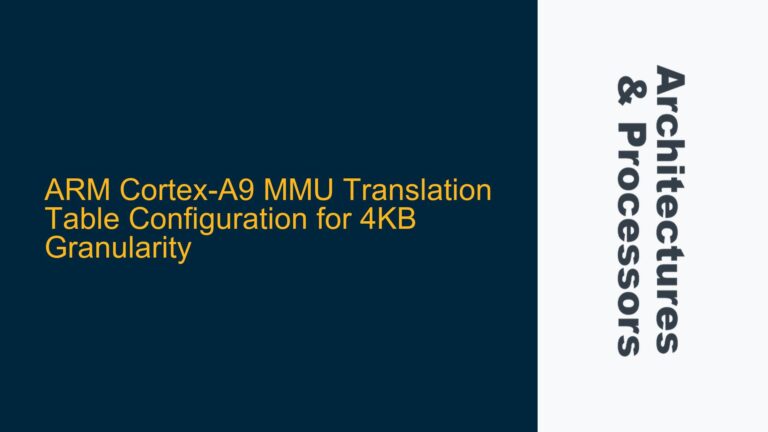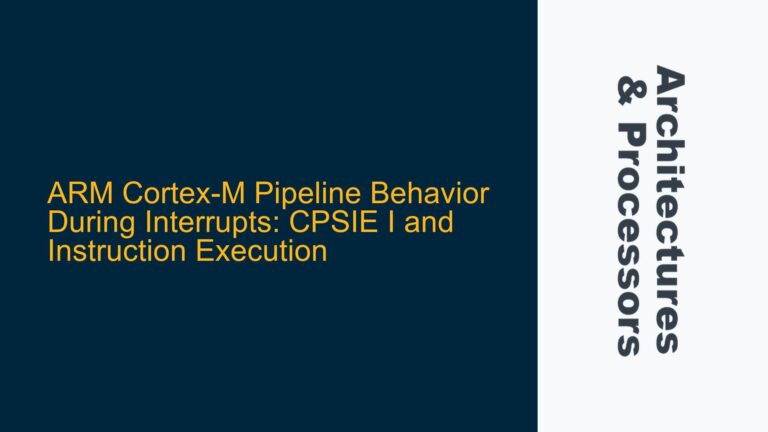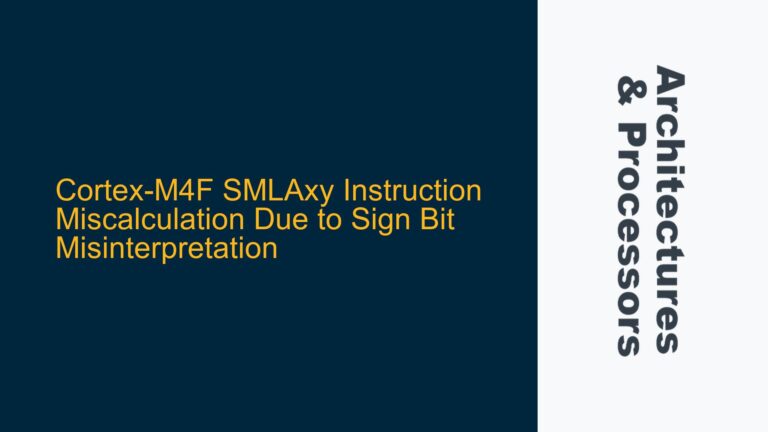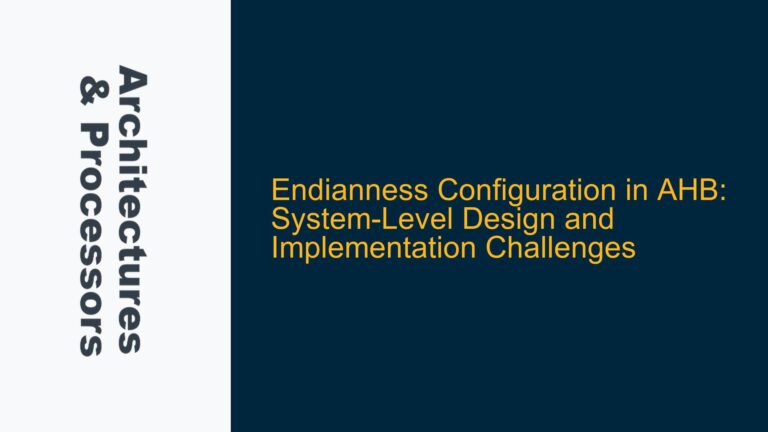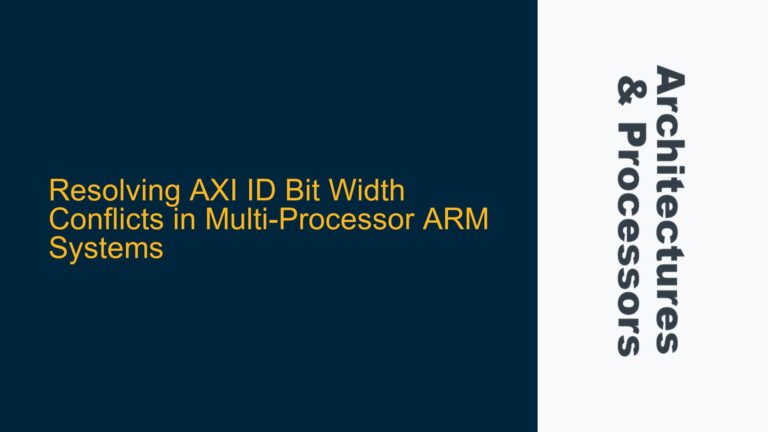Real-Time Performance Limitations with Preempt-RT Patch on ARM Cortex-A57
The ARM Cortex-A57 is a high-performance processor core designed for applications requiring both computational power and energy efficiency. However, when implementing real-time systems on platforms like the NVIDIA Jetson TX2, which utilizes the Cortex-A57, developers often encounter challenges in achieving hard real-time performance. The Preempt-RT patch for Linux is a common approach to enhance the real-time capabilities of the Linux kernel. While the Preempt-RT patch improves the kernel’s responsiveness by making it more preemptible, it does not guarantee hard real-time performance. This limitation arises due to several factors inherent in the design of the Cortex-A57 and the Linux kernel.
The Cortex-A57 features a complex pipeline with out-of-order execution, speculative execution, and advanced branch prediction. These features, while beneficial for general-purpose performance, introduce variability in execution timing, which is problematic for real-time systems that require deterministic behavior. Additionally, the Linux kernel, even with the Preempt-RT patch, is not designed to provide hard real-time guarantees. The kernel’s scheduling policies, interrupt handling mechanisms, and memory management subsystems can introduce unpredictable latencies. For instance, the kernel’s handling of system calls, page faults, and interrupts can lead to jitter in task execution times, making it difficult to meet strict real-time deadlines.
Furthermore, the Preempt-RT patch does not address all sources of latency in the system. For example, the patch reduces the maximum preemption latency by making more kernel code preemptible, but it does not eliminate all sources of non-determinism. The Cortex-A57’s cache hierarchy, which includes L1, L2, and shared L3 caches, can also introduce variability in memory access times. Cache misses, cache coherency traffic, and contention for shared resources can lead to unpredictable delays, further complicating the achievement of hard real-time performance.
In summary, while the Preempt-RT patch improves the real-time capabilities of the Linux kernel on the ARM Cortex-A57, it does not provide the deterministic behavior required for hard real-time systems. The Cortex-A57’s architectural features, combined with the Linux kernel’s design, introduce variability in execution timing that can prevent the system from meeting strict real-time deadlines.
Architectural and Kernel-Level Sources of Non-Determinism
The challenges in achieving hard real-time performance on the ARM Cortex-A57 with the Preempt-RT patch can be attributed to several architectural and kernel-level factors. Understanding these sources of non-determinism is crucial for identifying potential solutions and workarounds.
One of the primary sources of non-determinism is the Cortex-A57’s out-of-order execution engine. Out-of-order execution allows the processor to execute instructions in an order that maximizes throughput, rather than strictly following the program order. While this improves overall performance, it introduces variability in the timing of instruction execution. For real-time tasks, this variability can lead to missed deadlines, as the exact time at which a task completes can vary depending on the state of the processor’s execution engine.
Another significant source of non-determinism is the Cortex-A57’s speculative execution. Speculative execution allows the processor to execute instructions ahead of time, based on predictions about the program’s control flow. If the predictions are correct, this can improve performance. However, if the predictions are incorrect, the processor must discard the speculatively executed instructions and restart execution from the correct path. This speculative execution can introduce additional variability in task execution times, as the time required to recover from a misprediction can vary depending on the depth of the speculation and the complexity of the pipeline.
The Cortex-A57’s cache hierarchy also contributes to non-determinism. The processor features a multi-level cache system, including private L1 and L2 caches for each core, and a shared L3 cache. While caches improve performance by reducing memory access latency, they can also introduce variability in memory access times. Cache misses, which occur when the required data is not found in the cache, can lead to significant delays as the processor must fetch the data from main memory. Additionally, cache coherency traffic, which ensures that all cores have a consistent view of memory, can introduce further variability, especially in multi-core systems where multiple cores are accessing shared data.
At the kernel level, the Linux kernel’s scheduling policies and interrupt handling mechanisms can also introduce non-determinism. The Preempt-RT patch improves the kernel’s preemptibility, but it does not eliminate all sources of latency. For example, the kernel’s handling of system calls, page faults, and interrupts can introduce unpredictable delays. The kernel’s scheduler, which is responsible for determining which task runs next, may not always prioritize real-time tasks over non-real-time tasks, leading to potential delays in task execution. Additionally, the kernel’s interrupt handling mechanism, which is responsible for responding to hardware interrupts, can introduce jitter in task execution times, especially if interrupts are frequent or if the interrupt service routines (ISRs) are long-running.
In summary, the ARM Cortex-A57’s architectural features, including out-of-order execution, speculative execution, and cache hierarchy, introduce variability in task execution times that can prevent the system from meeting hard real-time deadlines. Additionally, the Linux kernel’s scheduling policies and interrupt handling mechanisms can further contribute to non-determinism, even with the Preempt-RT patch applied.
Strategies for Achieving Hard Real-Time Performance on ARM Cortex-A57
Achieving hard real-time performance on the ARM Cortex-A57 requires a combination of hardware and software strategies to address the sources of non-determinism identified earlier. These strategies include optimizing the use of the Cortex-A57’s architectural features, modifying the Linux kernel to reduce latency, and leveraging alternative real-time operating systems (RTOS) that are better suited for hard real-time applications.
One approach to reducing variability in task execution times is to optimize the use of the Cortex-A57’s out-of-order execution engine. This can be achieved by carefully designing real-time tasks to minimize dependencies between instructions, allowing the processor to execute instructions in parallel without introducing significant variability. Additionally, developers can use compiler optimizations to generate code that is more amenable to out-of-order execution, such as loop unrolling and instruction scheduling.
Another strategy is to mitigate the impact of speculative execution by reducing the likelihood of mispredictions. This can be achieved by using branch prediction hints, which provide the processor with information about the likely outcome of branch instructions, reducing the likelihood of mispredictions. Additionally, developers can design real-time tasks to minimize the use of complex control flow, reducing the opportunities for speculative execution to introduce variability.
To address the variability introduced by the Cortex-A57’s cache hierarchy, developers can use cache partitioning techniques to ensure that real-time tasks have exclusive access to certain cache lines. This can reduce the likelihood of cache misses and cache coherency traffic, improving the predictability of memory access times. Additionally, developers can use cache locking techniques to pin critical data in the cache, ensuring that it is always available when needed.
At the kernel level, developers can modify the Linux kernel to reduce latency and improve the predictability of task execution. This can include optimizing the kernel’s scheduler to prioritize real-time tasks over non-real-time tasks, reducing the likelihood of delays in task execution. Additionally, developers can optimize the kernel’s interrupt handling mechanism to reduce jitter in task execution times, such as by using threaded interrupts or reducing the length of interrupt service routines.
For applications that require hard real-time guarantees, developers may consider using an alternative RTOS that is specifically designed for real-time performance. RTOSes such as FreeRTOS, Zephyr, or ERIKA Enterprise provide deterministic behavior and are better suited for hard real-time applications than the Linux kernel, even with the Preempt-RT patch applied. These RTOSes typically have simpler scheduling policies, reduced interrupt handling latencies, and more predictable memory management, making them more suitable for real-time systems.
In summary, achieving hard real-time performance on the ARM Cortex-A57 requires a combination of hardware and software strategies to address the sources of non-determinism. These strategies include optimizing the use of the Cortex-A57’s architectural features, modifying the Linux kernel to reduce latency, and leveraging alternative RTOSes that are better suited for hard real-time applications. By carefully designing real-time tasks and optimizing the system at both the hardware and software levels, developers can improve the predictability of task execution times and meet strict real-time deadlines.

